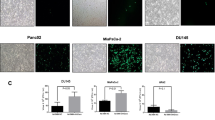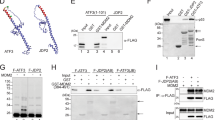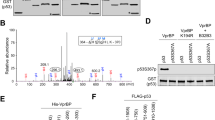Abstract
Wild-type adenovirus type 5 eliminates p53 through the E1B-55kDa and E4-34kDa gene products. Deletion or mutation of E1B-55kDa has long been thought to confer p53-selective replication of oncolytic viruses. We show here that infection with E1B-defective adenovirus mutants induces massive accumulation of p53, without obvious defects in p53 localization, phosphorylation, conformation and oligomerization. Nonetheless, p53 completely failed to induce its target genes in this scenario, for example, p21/CDKN1A, Mdm2 and PUMA. Two regions of the E1A gene products independently contributed to the suppression of p21 transcription. Depending on the E1A conserved region 3, E1B-defective adenovirus impaired the ability of the transcription factor Sp1 to bind the p21 promoter. Moreover, the amino terminal region of E1A, binding the acetyl transferases p300 and CREB-binding protein, blocked p53 K382 acetylation in infected cells. Mutating either of these E1A regions, in addition to E1B, partially restored p21 mRNA levels. Our findings argue that adenovirus attenuates p53-mediated p21 induction, through at least two E1B-independent mechanisms. Other virus species and cancer cells may employ analogous strategies to impair p53 activity.
This is a preview of subscription content, access via your institution
Access options
Subscribe to this journal
Receive 50 print issues and online access
$259.00 per year
only $5.18 per issue
Buy this article
- Purchase on Springer Link
- Instant access to full article PDF
Prices may be subject to local taxes which are calculated during checkout





Similar content being viewed by others
References
Atz J, Wagner P, Roemer K . (2000). Function, oligomerization, and conformation of tumor-associated p53 proteins with mutated C-terminus. J Cell Biochem 76: 572–584.
Avantaggiati ML, Ogryzko V, Gardner K, Giordano A, Levine AS, Kelly K . (1997). Recruitment of p300/CBP in p53-dependent signal pathways. Cell 89: 1175–1184.
Beckerman R, Donner AJ, Mattia M, Peart MJ, Manley JL, Espinosa JM et al. (2009). A role for Chk1 in blocking transcriptional elongation of p21 RNA during the S-phase checkpoint. Genes Dev 23: 1364–1377.
Bernat A, Avvakumov N, Mymryk JS, Banks L . (2003). Interaction between the HPV E7 oncoprotein and the transcriptional coactivator p300. Oncogene 22: 7871–7881.
Bischoff JR, Kirn DH, Williams A, Heise C, Horn S, Muna M et al. (1996). An adenovirus mutant that replicates selectively in p53-deficient human tumor cells. Science 274: 373–376.
Bode AM, Dong Z . (2004). Post-translational modification of p53 in tumorigenesis. Nat Rev Cancer 4: 793–805.
Bond GL, Hu W, Bond EE, Robins H, Lutzker SG, Arva NC et al. (2004). A single nucleotide polymorphism in the MDM2 promoter attenuates the p53 tumor suppressor pathway and accelerates tumor formation in humans. Cell 119: 591–602.
Braun CJ, Zhang X, Savelyeva I, Wolff S, Moll UM, Schepeler T et al. (2008). p53-Responsive micrornas 192 and 215 are capable of inducing cell cycle arrest. Cancer Res 68: 10094–10104.
Bridge E, Ketner G . (1990). Interaction of adenoviral E4 and E1b products in late gene expression. Virology 174: 345–353.
Carlock LR, Jones NC . (1981). Transformation-defective mutant of adenovirus type 5 containing a single altered E1a mRNA species. J Virol 40: 657–664.
Debbas M, White E . (1993). Wild-type p53 mediates apoptosis by E1A, which is inhibited by E1B. Genes Dev 7: 546–554.
Dobner T, Horikoshi N, Rubenwolf S, Shenk T . (1996). Blockage by adenovirus E4orf6 of transcriptional activation by the p53 tumor suppressor. Science 272: 1470–1473.
Faiola F, Liu X, Lo S, Pan S, Zhang K, Lymar E et al. (2005). Dual regulation of c-Myc by p300 via acetylation-dependent control of Myc protein turnover and coactivation of Myc-induced transcription. Mol Cell Biol 25: 10220–10234.
Ferrari R, Pellegrini M, Horwitz GA, Xie W, Berk AJ, Kurdistani SK . (2008). Epigenetic reprogramming by adenovirus e1a. Science 321: 1086–1088.
Ferreon JC, Martinez-Yamout MA, Dyson HJ, Wright PE . (2009). Structural basis for subversion of cellular control mechanisms by the adenoviral E1A oncoprotein. Proc Natl Acad Sci USA 106: 13260–13265.
Gartel AL, Ye X, Goufman E, Shianov P, Hay N, Najmabadi F et al. (2001). Myc represses the p21(WAF1/CIP1) promoter and interacts with Sp1/Sp3. Proc Natl Acad Sci USA 98: 4510–4515.
Goodrum FD, Ornelles DA . (1998). p53 status does not determine outcome of E1B 55-kilodalton mutant adenovirus lytic infection. J Virol 72: 9479–9490.
Gottifredi V, Shieh S, Taya Y, Prives C . (2001). p53 accumulates but is functionally impaired when DNA synthesis is blocked. Proc Natl Acad Sci USA 98: 1036–1041.
Harada H, Nakagawa H, Oyama K, Takaoka M, Andl CD, Jacobmeier B et al. (2003). Telomerase induces immortalization of human esophageal keratinocytes without p16INK4a inactivation. Mol Cancer Res 1: 729–738.
Harlow E, Whyte P, Franza Jr BR, Schley C . (1986). Association of adenovirus early-region 1A proteins with cellular polypeptides. Mol Cell Biol 6: 1579–1589.
Harrod R, Nacsa J, Van Lint C, Hansen J, Karpova T, McNally J et al. (2003). Human immunodeficiency virus type-1 Tat/co-activator acetyltransferase interactions inhibit p53Lys-320 acetylation and p53-responsive transcription. J Biol Chem 278: 12310–12318.
Heise C, Sampson-Johannes A, Williams A, McCormick F, Von Hoff DD, Kirn DH . (1997). ONYX-015, an E1B gene-attenuated adenovirus, causes tumor-specific cytolysis and antitumoral efficacy that can be augmented by standard chemotherapeutic agents. Nat Med 3: 639–645.
Hobom U, Dobbelstein M . (2004). E1B-55-kilodalton protein is not required to block p53-induced transcription during adenovirus infection. J Virol 78: 7685–7697.
Hsu CH, Chang MD, Tai KY, Yang YT, Wang PS, Chen CJ et al. (2004). HCMV IE2-mediated inhibition of HAT activity downregulates p53 function. Embo J 23: 2269–2280.
Ito A, Lai CH, Zhao X, Saito S, Hamilton MH, Appella E et al. (2001). p300/CBP-mediated p53 acetylation is commonly induced by p53-activating agents and inhibited by MDM2. Embo J 20: 1331–1340.
Iyer NG, Ozdag H, Caldas C . (2004). p300/CBP and cancer. Oncogene 23: 4225–4231.
Jones N, Shenk T . (1979). Isolation of adenovirus type 5 host range deletion mutants defective for transformation of rat embryo cells. Cell 17: 683–689.
Koch P, Gatfield J, Lober C, Hobom U, Lenz-Stoppler C, Roth J et al. (2001). Efficient replication of adenovirus despite the overexpression of active and nondegradable p53. Cancer Res 61: 5941–5947.
Koutsodontis G, Vasilaki E, Chou WC, Papakosta P, Kardassis D . (2005). Physical and functional interactions between members of the tumour suppressor p53 and the Sp families of transcription factors: importance for the regulation of genes involved in cell-cycle arrest and apoptosis. Biochem J 389: 443–455.
Lagger G, Doetzlhofer A, Schuettengruber B, Haidweger E, Simboeck E, Tischler J et al. (2003). The tumor suppressor p53 and histone deacetylase 1 are antagonistic regulators of the cyclin-dependent kinase inhibitor p21/WAF1/CIP1 gene. Mol Cell Biol 23: 2669–2679.
Levine AJ . (2009). The common mechanisms of transformation by the small DNA tumor viruses: The inactivation of tumor suppressor gene products: p53. Virology 384: 285–293.
Lill NL, Grossman SR, Ginsberg D, DeCaprio J, Livingston DM . (1997). Binding and modulation of p53 by p300/CBP coactivators. Nature 387: 823–827.
Liu F, Green MR . (1994). Promoter targeting by adenovirus E1a through interaction with different cellular DNA-binding domains. Nature 368: 520–525.
Lowe SW, Ruley HE . (1993). Stabilization of the p53 tumor suppressor is induced by adenovirus 5 E1A and accompanies apoptosis. Genes Dev 7: 535–545.
O'Shea CC, Johnson L, Bagus B, Choi S, Nicholas C, Shen A et al. (2004). Late viral RNA export, rather than p53 inactivation, determines ONYX-015 tumor selectivity. Cancer Cell 6: 611–623.
O'Shea CC, Soria C, Bagus B, McCormick F . (2005). Heat shock phenocopies E1B-55 K late functions and selectively sensitizes refractory tumor cells to ONYX-015 oncolytic viral therapy. Cancer Cell 8: 61–74.
Pilder S, Moore M, Logan J, Shenk T . (1986). The adenovirus E1B-55 K transforming polypeptide modulates transport or cytoplasmic stabilization of viral and host cell mRNAs. Mol Cell Biol 6: 470–476.
Ray R, Snyder RC, Thomas S, Koller CA, Miller DM . (1989). Mithramycin blocks protein binding and function of the SV40 early promoter. J Clin Invest 83: 2003–2007.
Rothmann T, Hengstermann A, Whitaker NJ, Scheffner M, zur Hausen H . (1998). Replication of ONYX-015, a potential anticancer adenovirus, is independent of p53 status in tumor cells. J Virol 72: 9470–9478.
Shen Y, Kitzes G, Nye JA, Fattaey A, Hermiston T . (2001). Analyses of single-amino-acid substitution mutants of adenovirus type 5 E1B-55K protein. J Virol 75: 4297–4307.
Shepherd SE, Howe JA, Mymryk JS, Bayley ST . (1993). Induction of the cell cycle in baby rat kidney cells by adenovirus type 5 E1A in the absence of E1B and a possible influence of p53. J Virol 67: 2944–2949.
Steegenga WT, van Laar T, Riteco N, Mandarino A, Shvarts A, van der Eb AJ et al. (1996). Adenovirus E1A proteins inhibit activation of transcription by p53. Mol Cell Biol 16: 2101–2109.
Thornborrow EC, Manfredi JJ . (2001). The tumor suppressor protein p53 requires a cofactor to activate transcriptionally the human BAX promoter. J Biol Chem 276: 15598–15608.
Turnell AS, Grand RJ, Gallimore PH . (1999). The replicative capacities of large E1B-null group A and group C adenoviruses are independent of host cell p53 status. J Virol 73: 2074–2083.
Turnell AS, Grand RJ, Gorbea C, Zhang X, Wang W, Mymryk JS et al. (2000). Regulation of the 26S proteasome by adenovirus E1A. Embo J 19: 4759–4773.
Wang X, Wang J, Lin S, Geng Y, Wang J, Jiang B . (2008). Sp1 is involved in H2O2-induced PUMA gene expression and apoptosis in colorectal cancer cells. J Exp Clin Cancer Res 27: 44.
Weigel S, Dobbelstein M . (2000). The nuclear export signal within the E4orf6 protein of adenovirus type 5 supports virus replication and cytoplasmic accumulation of viral mRNA. J Virol 74: 764–772.
Wong K, Sharma A, Awasthi S, Matlock EF, Rogers L, Van Lint C et al. (2005). HIV-1 Tat interactions with p300 and PCAF transcriptional coactivators inhibit histone acetylation and neurotrophin signaling through CREB. J Biol Chem 280: 9390–9399.
Zhao Y, Lu S, Wu L, Chai G, Wang H, Chen Y et al. (2006). Acetylation of p53 at lysine 373/382 by the histone deacetylase inhibitor depsipeptide induces expression of p21(Waf1/Cip1). Mol Cell Biol 26: 2782–2790.
Acknowledgements
We thank JS Mymryk, RJA Grand, X Zhang and G Ketner for viruses, K Roemer for plasmids, AJ Levine for antibodies, OG Opitz for cells, C Hippel and A Dickmanns for excellent technical assistance, and S Johnsen for the help with ChIP experiments. The work was supported by the German Cancer Aid/Dr Mildred Scheel Stiftung, the EU 6th Framework Program (Integrated Project Active p53), the German Research Foundation (DFG), the Wilhelm Sander Stiftung, the Statens Sundhedsvidenskabelige Forskningsråd of Denmark, the Danish Cancer Society, and the Novonordisk fonden.
Author information
Authors and Affiliations
Corresponding author
Ethics declarations
Competing interests
The authors declare no conflict of interest.
Additional information
Supplementary Information accompanies the paper on the Oncogene website
Supplementary information
Rights and permissions
About this article
Cite this article
Savelyeva, I., Dobbelstein, M. Infection with E1B-mutant adenovirus stabilizes p53 but blocks p53 acetylation and activity through E1A. Oncogene 30, 865–875 (2011). https://doi.org/10.1038/onc.2010.461
Received:
Revised:
Accepted:
Published:
Issue Date:
DOI: https://doi.org/10.1038/onc.2010.461
Keywords
This article is cited by
-
Orchestration of protein acetylation as a toggle for cellular defense and virus replication
Nature Communications (2018)



